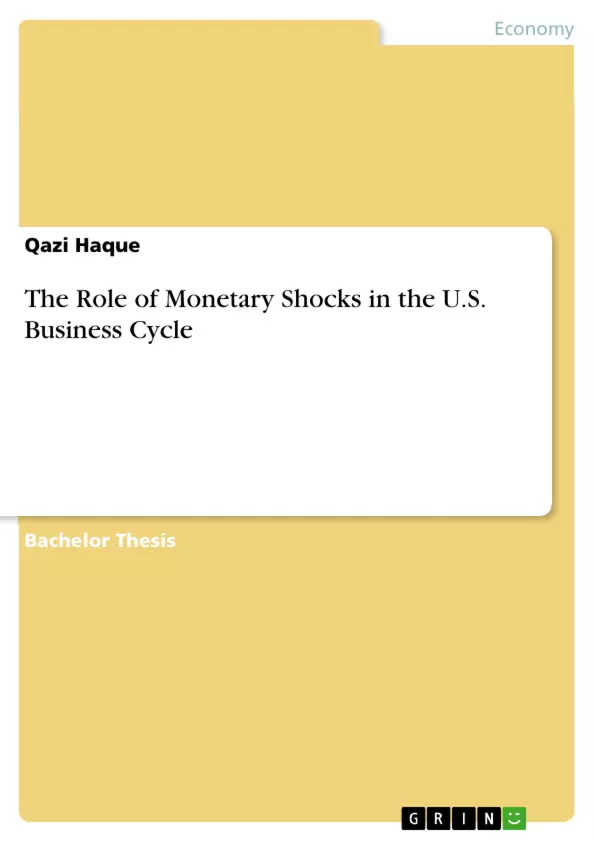The purpose of this study is to illustrate how the basic Real Business Cycle (RBC) model can be modified to incorporate money in an attempt to construct monetary business cycle models of the U.S. economy. This is done for one case where money enters the model as direct lump-sum transfers to households and for the other case where money injections enter the economy through the financial system. Interestingly, the two channels generate very different responses to a money growth shock. In the first case, a positive money growth shock increases nominal interest rates and depresses economic activity, which is called the anticipated inflation effect. However, the popular consensus among economists is that nominal interest rates fall after a positive monetary shock. This motivates the construction of our second model where it is conjectured that the banking sector plays an important role in the monetary transmission mechanism and money is injected into the model through financial intermediaries. It is observed in this model that a positive monetary shock reduces interest rates and stimulates economic activity, which is called the liquidity effect. Furthermore, the statistics generated by the models show that monetary shocks have no effect on real variables when money enters as direct lump-sum transfers to households. On the contrary, such shocks have significant real impact when money enters through the financial system. Taken together, this implies that how money enters into the model significantly matters for the impact of monetary shocks and such shocks entering through financial intermediaries may be important in determining the cyclical fluctuations of the U.S. economy.
Inhaltsverzeichnis (Table of Contents)
- Introduction
- Literature review
- Data
- Stylized Facts of U.S. Business Cycles
- The Hodrick-Prescott Filter
- Features of U.S. business cycles
- Baseline Cash-in-Advance Model
- The Structure
- The Full Model
- The Stationary State
- Calibration
- Impulse Responses for Cash-in-Advance Model
- Response to a technology shock
- Response to a money growth shock
- Assessing the baseline Cash-in-Advance Model
- Working Capital Model
- The Structure
- Households
- Firms
- Financial Intermediaries
- Monetary Policy
- The Optimization Problem
- The Representative Household's Problem
- The Representative Firm's Problem
- The Competitive Equilibrium
- The Stationary State
- Impulse Responses for Working Capital Model
- Response to a technology shock
- Response to a money growth shock when ŋ = 0
- Response to a money growth shock when ŋ = 1
- Assessing the Working Capital Model when y = 0
- Assessing the Working Capital Model when n 1
- The Structure
- Discussion
Zielsetzung und Themenschwerpunkte (Objectives and Key Themes)
This study aims to demonstrate how the Real Business Cycle (RBC) model can be modified to incorporate money and create monetary business cycle models for the U.S. economy. The research explores two scenarios: one where money enters as direct lump-sum transfers to households and another where money injections occur through the financial system.
- The role of money in the U.S. business cycle
- The impact of monetary shocks on economic activity
- The monetary transmission mechanism
- The contrasting effects of money entering through different channels
- The significance of financial intermediaries in the monetary transmission mechanism
Zusammenfassung der Kapitel (Chapter Summaries)
The first chapter provides an introduction to the research topic, setting the stage for the analysis of monetary shocks and their effects on the U.S. business cycle. The second chapter reviews relevant literature on the subject, offering context for the current study. Chapter 3 delves into the data used for the analysis, presenting the information that underpins the model construction and analysis. Chapter 4 analyzes stylized facts of U.S. business cycles, focusing on features of the cycle and the Hodrick-Prescott filter. Chapter 5 introduces the baseline Cash-in-Advance model, detailing its structure, full model, stationary state, calibration, and impulse responses to technology and money growth shocks. This chapter assesses the model's performance in capturing real-world economic dynamics. Chapter 6 explores the Working Capital model, examining its structure, including households, firms, financial intermediaries, and monetary policy. The chapter details the model's optimization problem, competitive equilibrium, stationary state, and impulse responses to technology and money growth shocks under different scenarios. It also evaluates the model's performance. Chapter 7 presents a discussion of the findings from the study, highlighting the key insights gained from the analysis of the two models.
Schlüsselwörter (Keywords)
The research focuses on business cycles, monetary shocks, monetary transmission mechanisms, financial intermediaries, anticipated inflation effects, and liquidity effects. The study explores the importance of how money enters the model, examining its impact on the U.S. economy and cyclical fluctuations.
- Citation du texte
- Qazi Haque (Auteur), 2013, The Role of Monetary Shocks in the U.S. Business Cycle, Munich, GRIN Verlag, https://www.grin.com/document/293495



